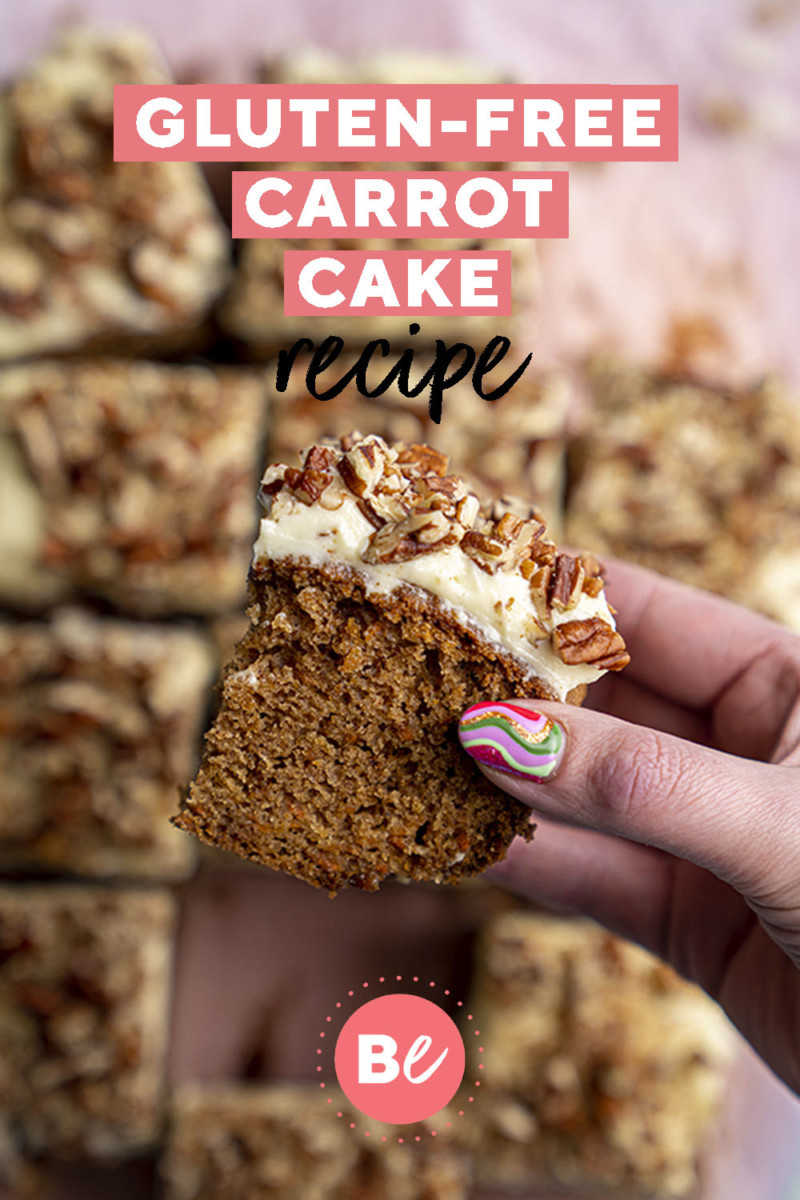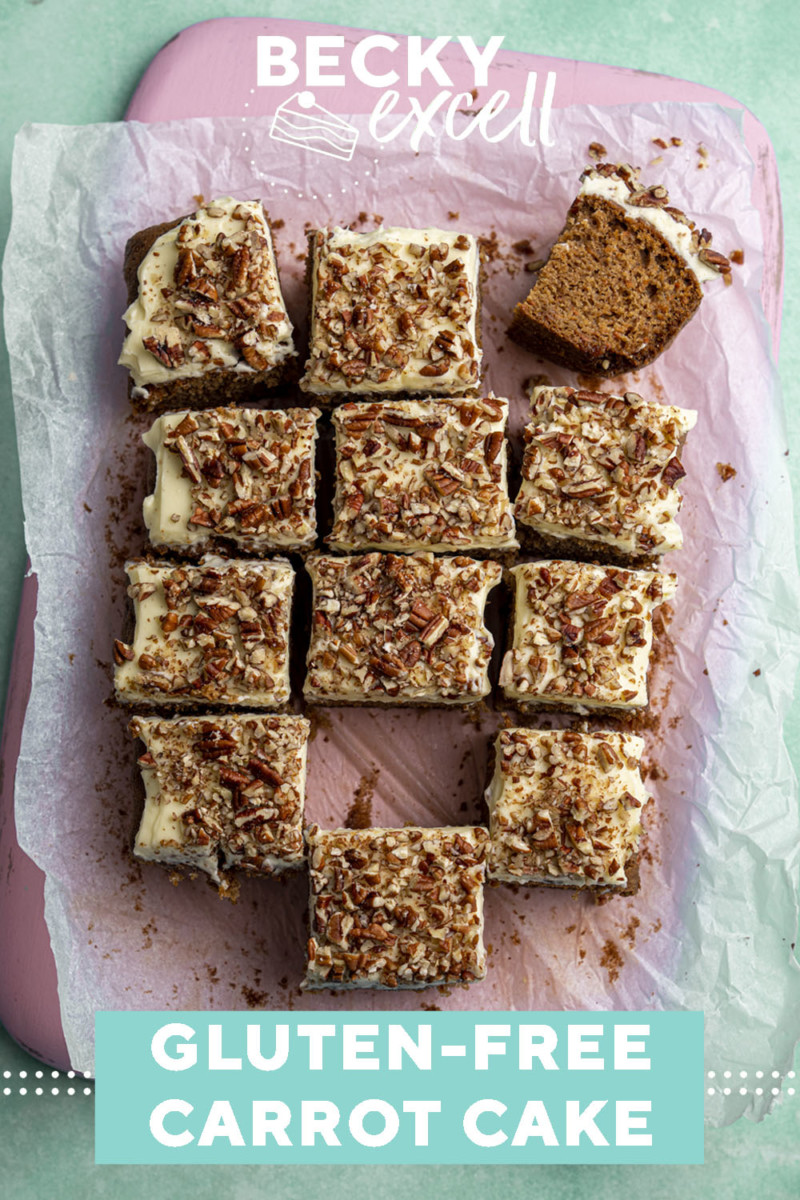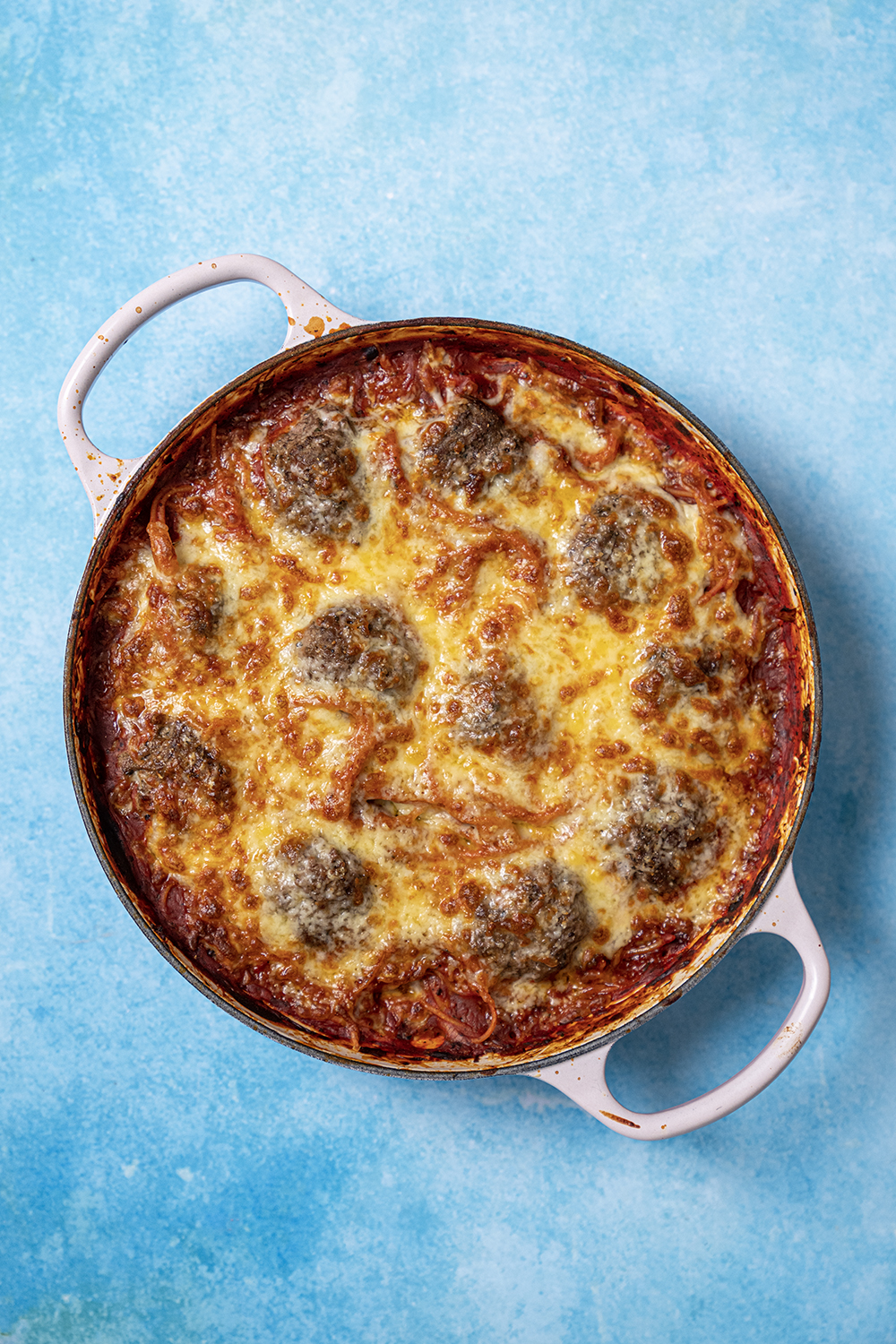Carrot cake traybake recipe – a tried and tested blog favourite that once disappeared… but is now back by popular demand! Of course, it’s gluten-free and Coeliac-friendly too.
Carrot cake traybake recipe, anyone? I’ve had so many posts in the group over the last year asking where the recipe went and I’ve got good news – I found it! So here it is in all its former glory…
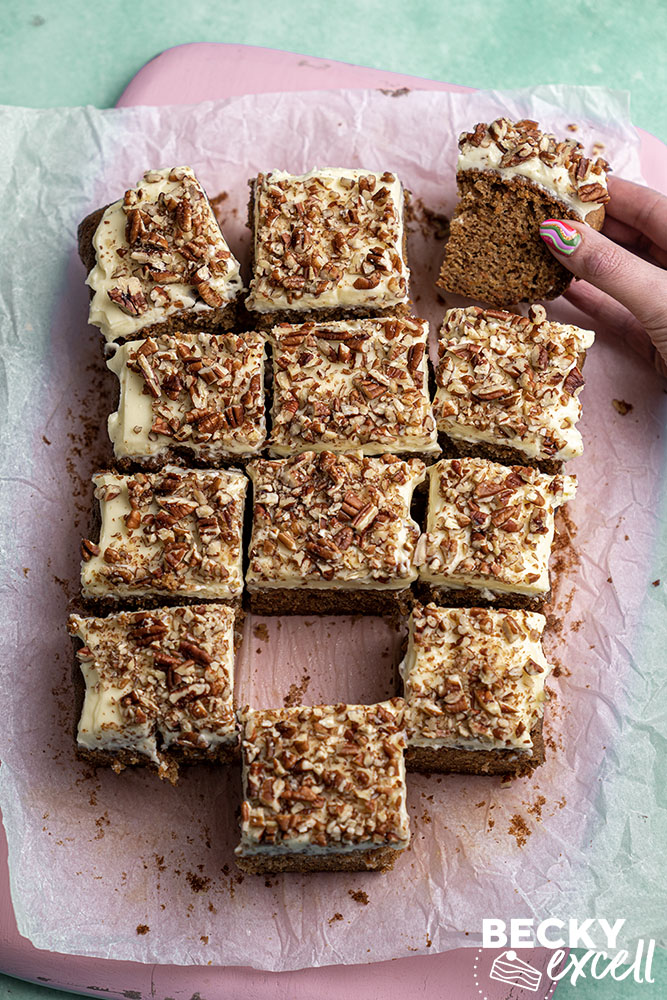
But wait… where was it hiding anyway?! Well, if you’re nosy, keep reading for the very boring reason or skip ahead for the recipe to get baking ASAP.
Basically, I’ve always had two separate carrot cake recipes here on the blog: my gluten-free carrot loaf cake and this one, first posted in May 2019. Both gluten-free, just two slightly different recipes in different baking tins. Still with me?!
However, when you typed in ‘gluten-free carrot cake recipe’ into Google, neither would show up at all amongst pages and pages of results. I’m guessing that, with two gluten-free carrot cake recipes, Google didn’t know which one it should show… so it decided to show neither. Great.
Sadly, the only way I could solve it was to remove this one entirely – which worked! Fast-forward to today and I’m reposting this version for all the folks who missed it; fingers crossed it won’t mess with the other one again and my sincere apologies for taking it down!
Carrot cake traybake recipe: What you’ll need…
- Vegetable oil: In cakes that don’t use butter, vegetable oil is usually a common ingredient instead. As oil never sets hard like butter would, it means that you’ll find your cake is super moist and stays that way for longer.
- Eggs: Medium or large (UK size) eggs are fine for this recipe. I used large.
- Light brown sugar: This is key for that distinctive caramelised, carrot cake-like sweetness, which works so well with the spices below.
- Gluten-free self-raising flour: This is a simple gluten-free flour blend I buy in the supermarket free from aisle. If you can’t find this where you live, you can always make your own using my flour blend recipe here.
- Bicarbonate of soda: This is also known as baking soda, but don’t confuse it with baking powder! Bicarb is much stronger and certainly not replaceable with baking powder.
- Xanthan gum: This is a binder commonly used in gluten-free baking. You’ll find it down the free from aisle in supermarkets, though it’s not super important if you leave it out of this recipe as the flour blend has a little in it already.
- Ground cinnamon and ginger: These are my spices of choice, adding a subtle warmth that works so well against the light brown sugar and nuts.
- Orange zest: Definitely don’t overlook this when creating the ultimate carrot cake flavour! A subtle citrus flavour means the difference between a spiced cake and a carrot cake.
- Carrots: Playing a super important role in this cake, the carrot adds moisture and subtle sweetness more than bold flavour.
- Walnuts or pecans: Either works fine – these are for putting into the actual cake (optional) as well as scattering on top of the cream cheese frosting.
- Butter: Though the cake itself doesn’t have butter in it, the cream cheese frosting does. Ensure it’s softened first, so get it out of the fridge 1-2 hours before you need it.
- Cream cheese: I used full-fat cream cheese for this recipe and I’d very strongly recommend you do too. Low-fat cream cheese lacks a high enough fat content to whip and you can end up with a very sloppy, unpleasant mixture!
- Icing sugar: This is a staple in almost any frosting or icing. In the US it’s known as confectioner’s sugar.
- Vanilla extract: The better quality your vanilla extract is, the better it will taste!
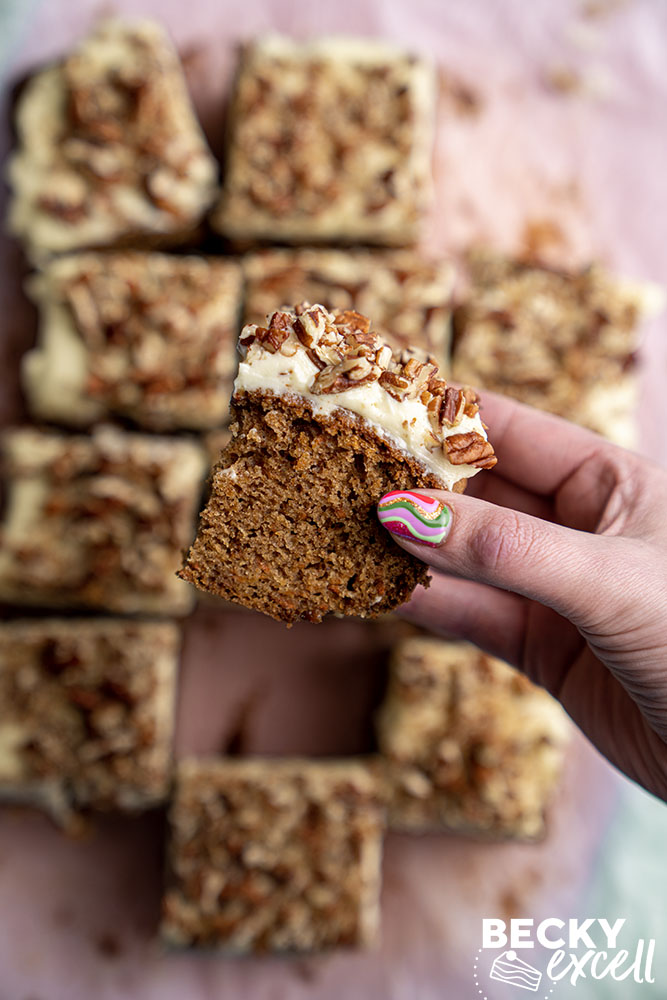
Well now you know the reason why my carrot cake traybake recipe might have given you deja vu, how does it taste?
I actually made the cake you see in the photos for Mark’s Mum’s birthday last week and the consensus was… that they loved it! And that’s why I always make it for special occasions – I can rely on it as an easy-to-share crowd pleaser.
The cake itself is incredibly moist thanks to the carrots, with a subtle, sweet spicing that gives it that undeniable carrot cake flavour. I don’t often put nuts or raisins into the cake itself as personally, I find it doesn’t even need them, but you’re more than welcome to add a generous handful of both to the cake batter.
In my opinion, you just can’t beat a cream cheese frosting, which offers a not-too-excessive layer of cheesecake filling-like luxury. The chopped walnuts or pecans on top tie everything together perfectly with a satisfying crunch in every bite.
Carrot cake traybake recipe: Frequently Asked Questions
Can I make this recipe gluten-free? Is it suitable for Coeliacs?
It is gluten-free, though nobody would know just by tasting it – trust me!
Bear in mind that minimising cross-contamination is hugely important if you’re Coeliac or making this for someone who is. Here’s some tips from Coeliac UK on minimising the risk of cross contamination.
Also, make sure that all ingredients used don’t have any gluten-containing ingredients. Then make sure that they also don’t have a ‘may contain’ warning for gluten, wheat, rye, barley, oats (which aren’t gf), spelt and khorasan wheat (aka Kamut).
Here’s some more info from Coeliac UK on identifying safe gluten-free products.
How do I make this recipe dairy-free?
The cake itself is dairy-free so nothing needs to change there.
As for the cream cheese frosting, I’d recommend you head over to my Victoria sponge cake recipe and make the icing from that recipe instead. Simply make it using Stork hard margarine or a hard vegan alternative to butter instead of actual butter.
Unfortunately, I’ve found that most dairy-free cream cheese isn’t a suitable like-for-like swap in cream cheese frosting as it’s often too soft and doesn’t whip well at all.
Can I make your carrot cake traybake recipe vegan?
Yep! If you follow the instructions above to make this recipe dairy free, then all you’ve got left to contend with is the eggs.
Here’s a few ideas you can use as egg replacements, so each of these = 1 egg.
- 3 tablespoons of aquafaba (whisked until frothy) – water from a can of chickpeas. Keep the chickpeas for a future dinner!
- 1 tbsp of ground flaxseed and 3 tbsp of water
- Egg replacement powder – I’d recommend using Orgran as it’s gluten free.
- 1 tablespoon of chia/flax seeds mixed with 2 tablespoons of water and left for 10 minutes in the fridge.
- 3 tablespoons of applesauce.
I haven’t tested all of these egg alternatives so let me know how you get on in the comments below.
Is this recipe low FODMAP?
Yes – as long as you use lactose-free cream cheese. That makes one slice of this cake suitable for the elimination phase of the low FODMAP diet.
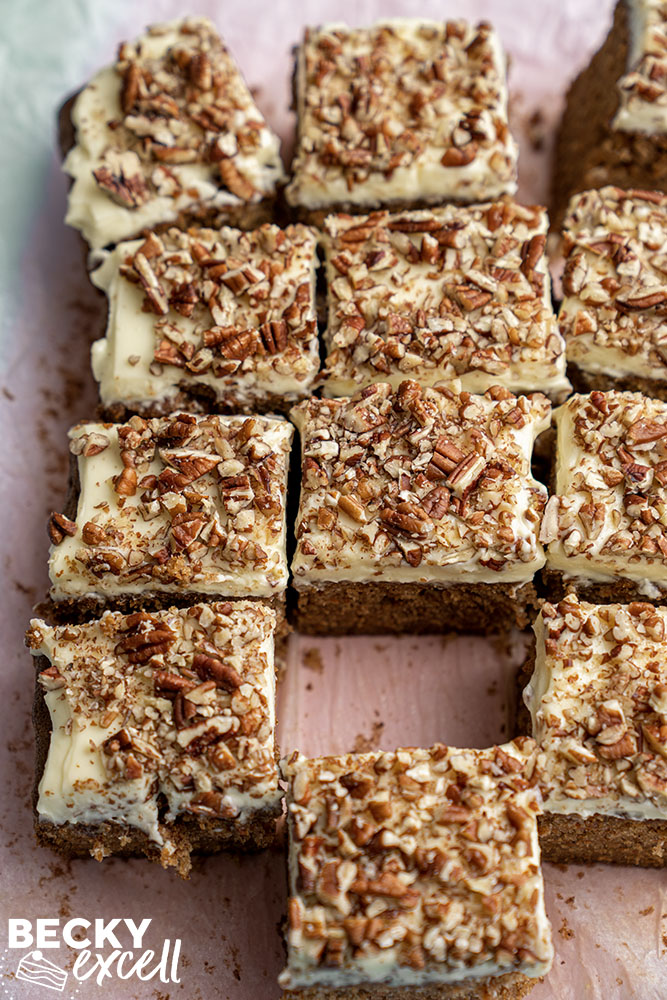
Do I need any special equipment to bake your carrot cake traybake?
Certainly not! Just a simple 32×21.5cm (12.5×8.5in) rectangular baking tin will do.
Can I use gluten-free flours like almond flour or coconut flour to make this recipe?
Certainly not using this recipe. This recipe uses a gluten-free flour blend which is easily available in supermarkets here in the UK.
If you can’t find it where you live, you can always make your own using my gluten-free flour recipe.
The reason you can’t use flours like almond or coconut in this recipe is because gluten-free flour is a blend of lots of different gluten-free flours and starches.
So to ditch a carefully made blend and try to substitute them all for ONE flour… it’s just not going to work!
Do I need weighing scales to make your carrot cake traybake recipe?
In short… yes, yes and yes! And I wouldn’t advise attempting any of my recipes without them. One of the worst things you can do in any recipe is alter the quantities by mistake or on purpose.
(unless you know what you’re doing of course)
Why? Well, you’re sort of just gambling with the recipe and praying that it turns out ok, don’t you think? And I’ve generally already done the hard work there for you, so you don’t have to do the guesswork with measurements!
A lot of work went into fine tuning ratios and quantities so I wouldn’t mess around with them unless you really know your stuff. I’d recommending using digital cooking scales like these so you know you’re getting an accurate measurement and replicating my recipe as accurately as poss.
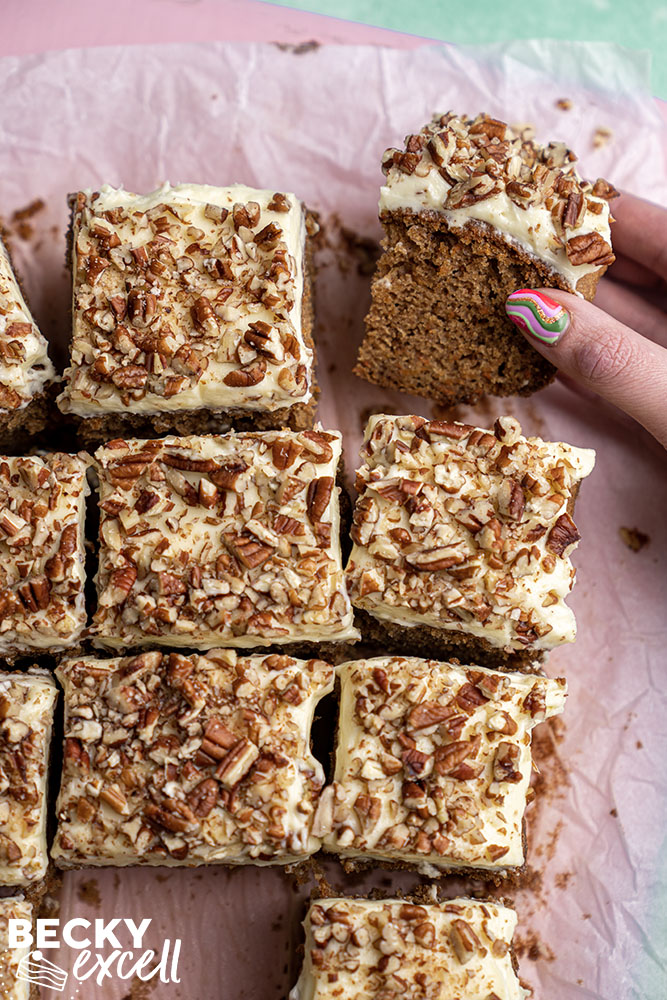
Carrot cake traybake recipe: Tips for perfection!
- Follow the recipe and add the ingredients in stages – that way, you can ensure everything is properly incorporated before adding the next ingredients. Don’t use the all-in-one method for this one!
- Don’t forget that you can ‘lazy line’ your baking tin. Simply scrunch up a large piece of baking paper and press it into the shape of the tin, then use pegs to hold it in place. Pour in the cake batter, then remove the pegs and bake – no greasing or paper cutting required!
- Poke the cake with a skewer in the middle to check if it’s done or not. If the skewer comes out clean, then it’s done – if not, pop it in for a bit longer.
- Wait until your cake has fully cooled before icing it. Otherwise the icing will melt and just drip off…!
- Use a long, sharp knife to slice. This will help you get nice equal slices – it’s a very long cake after all.
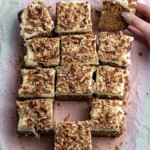
Carrot Cake Traybake Recipe
Ingredients
For the cake
- 300 ml vegetable oil
- 350 g light brown sugar
- 6 eggs
- 400 g gluten-free self-raising flour
- 2 tsp bicarbonate of soda
- 1/4 tsp xanthan gum
- 2 tsp ground cinnamon
- 1 tsp ground ginger
- zest of 1 large orange
- 350g -400g carrots grated
- 100 g walnuts or pecans, finely chopped (optional)
For the frosting/icing
- 150 g butter softened
- 300 g full-fat cream cheese (use lactose-free cream cheese if low FODMAP)
- 150 g icing sugar
- 1 tsp vanilla extract
- walnuts or pecans (for sprinkling on top)
Instructions
- Preheat your oven to 180C / 160C (fan) / 350F. Prepare a 32×21.5cm (12.5×8.5in) rectangular baking tin by greasing and lining with non-stick baking paper. The baking paper should go over the edges so you can use the paper to lift out the cake once it's cooled.
- In a large mixing bowl, add the oil, light brown sugar and eggs. Mix together (I use an electric hand whisk for this part) until well combined.
- Next, sift in the flour, bicarbonate of soda, xanthan gum, cinnamon and ginger. Gently fold these in to the mixture using a silicone spatula.
- Add the orange zest and grated carrot (at this stage you could add chopped walnuts, pecans or raisins if you like – I don't like raisins so sometimes choose to add nuts, but often don't bother!) Fold into the mixture so the carrot and orange zest is evenly dispersed.
- Spoon/pour the mixture into your baking tin and place in the oven for about 60 minutes. The cake should be cooked through, use a skewer to check.
- Leave the cake to cool in the tin until it firms up a bit. Then, carefully lift it out using the baking paper and then onto a cooling rack to cool completely.
- To make the cream cheese frosting, mix the softened butter in a stand mixer or with an electric hand mixer (in a mixing bowl) at a medium speed for 5 minutes or until paler in colour. Add the icing sugar and beat for about 3 minutes.
- Add in the cream cheese and vanilla and beat for 2–3 more minutes until well combined and the icing is light and fluffy, without lumps. Place in the fridge to chill briefly until you need it.
- Spread the frosting evenly all over your cake. With a carrot cake being a bit more delicate, be careful when spreading so none of the top layer comes off… it doesn't really matter if it does!
- Sprinkle the top of your cake with chopped up walnuts or pecans.
- Cut your cake into 12-15 squares and enjoy!
Notes
Nutrition
Thanks for reading all about my carrot cake traybake recipe! If you make it, I’d love to see how it turned out so don’t forget to take a snap of your creations and tag me on Instagram!
Any questions about the recipe? Please do let me know by following me on Instagram or TikTok and leaving me a comment on a recent post!
Thanks for reading,
Becky xxx
Don’t forget to pin this for later!
